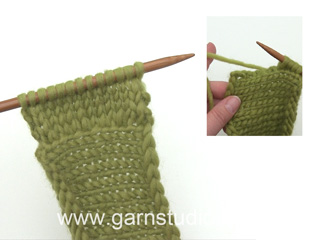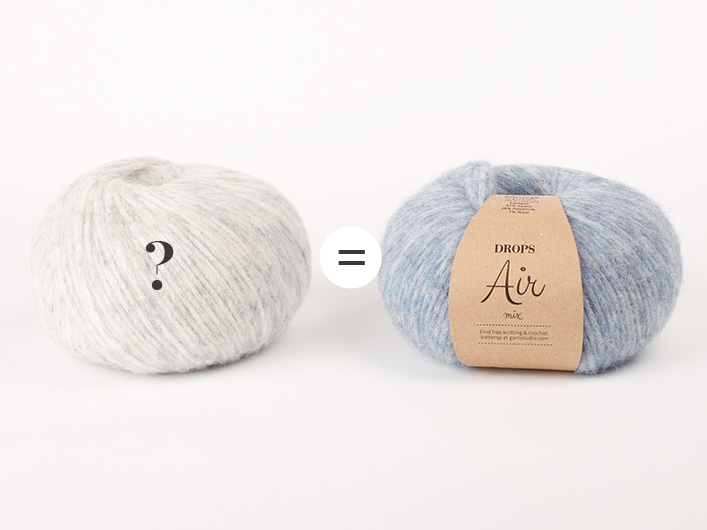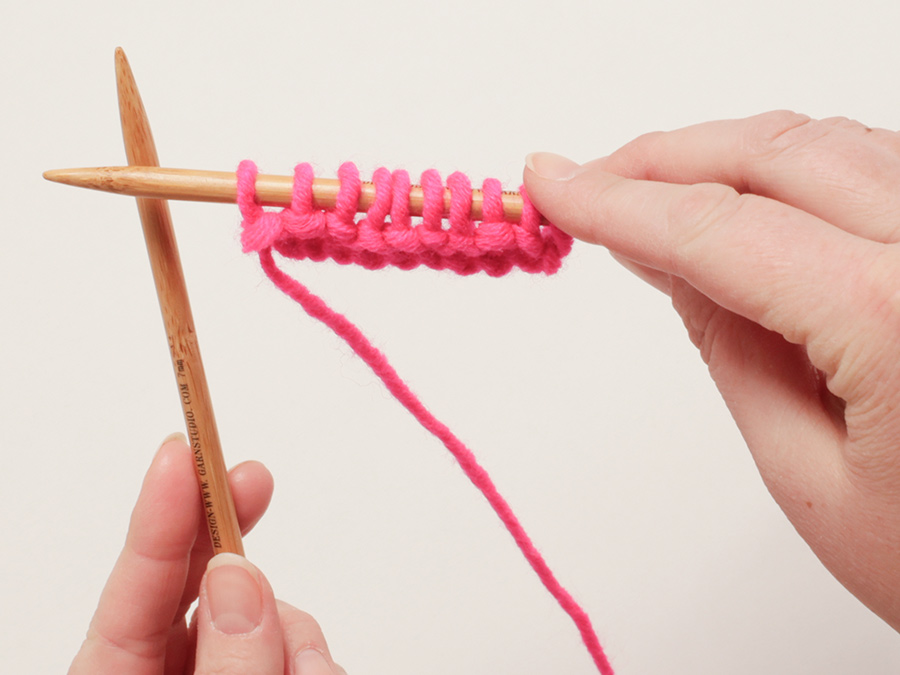Comments / Questions (161)
![]() Jennifer wrote:
Jennifer wrote:
Ich bin blutige Anfängerin im Pulloverstricken und verstehe die Blende leider überhaupt nicht. Mit den Abnahmen an den Seiten bin ich fertig. Wieso muss nun nach 36 cm der Faden abgeschnitten werden? Verstehe ich es richtig, dass ich dann die ersten 23 M ignoriere und bei der 24. M anfange, die Blende mit einem neuen Faden zu stricken? Was passiert mit den ersten 23 M? Wo lasse ich die?
29.04.2017 - 23:41DROPS Design answered:
Liebe Jennifer, von der Anschlagskante begannen Sie an einer der Seite (= 1. Markierer). Nach 36 cm stricken Sie hin- und zurück von der Mitte am Vorderteil, dh die erste Reihe wird nach dem ersten 23 M anfangen, diese 23 M stricken Sie dann am Ende dieser Reihe + 14 neue M hinter den ersten 14 M auffassen (siehe Video hier). Viel Spaß beim stricken!
02.05.2017 - 10:00
![]() Mille wrote:
Mille wrote:
Så faldt 10-øren endeligt :D Tusind tak for hjælpen!
04.10.2016 - 19:38
![]() Mille wrote:
Mille wrote:
Hej. Beklager meget, men Jeg forstår det desværre stadig ikke. Skal jeg strikke: 1: 14 ret, resten ret, 2: 14 ret, resten vrang, 3: 14 ret, resten ret, 4: 14 ret, resten vrang, 5: 14 vrang, resten ret, 6: 14 vrang, resten vrang Eller: 1: 14 ret, 82 ret, 14 ret, 2: 14 ret, 82 vrang, 14 ret, 3&4: gentag, 5: 14 vrang, 82 ret, 14 vrang, 6: 14 vrang, 82 vrang, 14 vrang Har prøvet begge og pillet hele skidtet op igen. Ingen af dem giver mønstret, så jeg har stadig ikke fanget den 😕
03.10.2016 - 19:47DROPS Design answered:
Hej Mille. Saadan ville jeg strikke: Du strikker 14 m forkant (ret), strik resten af pinden glat. Slaa 14 nye masker op bag forkanten, strik dem ret, glat, og 14 m forkant r. Vend, 14 m forkant r, glat, 14 m forkant bag r. Vend, 14 m forkant bag r, glat, 14 m forkant r. Vend, 14 m forkant vr, glat, 14 m forkant bag vr. Vend, 14 m forkant bag vr, glat, 14 m forkant vr. Vend, start forfra med 4 p r, 2 p vr over forkantmaskerne.
04.10.2016 - 14:51
![]() Mille wrote:
Mille wrote:
Hej. Jeg forstår ikke kraven. Hvis jeg strikket fire pinde ret og to vrang får jeg et helt andet mønster end på billedet. Skal jeg strikke hver side af kraven som en eller to pinde? Altså pind 1: 14 ret glatstrik og så slut med 14 ret eller vrang? Og hvad skal jeg så starte fra vrangsiden har set videoen 7-8 gange nu og det er ikke til at gennemskue, hvad de gør der - kan i hvert fald ikke få det til at passe med fire pinde ret og to vrang. Dumb it down please? :-)
02.10.2016 - 22:34DROPS Design answered:
Hej Mille. Du har to kraver: 1 foran og 1 bagved den förste (se billede). Du strikker over de förste 14 m krave rundt og ender med de 14 m krave bag den förste. Du strikker 4 pinde r frem og tilbage (rillestrik) og herefter 2 p vr staar der. Dvs, du strikker r, r, r, r, vr, vr, r, r, r, r, osv. Du faar da 4 riller og 2 p glat som paa billedet.
03.10.2016 - 10:40
![]() Caren Harju wrote:
Caren Harju wrote:
Confused... [19¾''-20''-20½''-21''-21¼''-21 5/8''] bind off 6 sts each side (i.e. 3 sts on each side of MT) for armhole = 98-106-118-130-142-154 sts. Now complete back and front pieces separately. How do I work each piece separately when they are on the same circular needles?
21.07.2016 - 00:35DROPS Design answered:
Dear Mrs Harju, keep the sts for back piece on needle (= 42-46-52-58-64-70 sts) to continue working back piece, and put the remaining sts for front pieces on a st holder, they will then slipped back later on needle. Happy knitting!
21.07.2016 - 09:11
![]() Doreen wrote:
Doreen wrote:
Hallo, wenn ich den faden abgeschnitten habe, soll ich ab Masche.... Wieder anfangen mit stricken, was mache ich mit den vorherigen maschen?
12.02.2016 - 13:19DROPS Design answered:
Liebe Doreen, bitte schreiben Sie, auf welche Stelle sich Ihre Frage bezieht.
06.03.2016 - 14:54
![]() Sarah wrote:
Sarah wrote:
Hallo liebe Strickhelfer, Ich bin gerade bei der Kapuze. Hier steht: "...Glatt mit je 14 Blendem in Krausrippe auf beiden Seiten stricken bis die Kapuze 35-35-36-36-37-37 cm misst. Danach abk. und die Kapuze hinten zusammen nähen." Müsste es nicht OBEN zusammen nähen heißen? Ich soll ja von den einen Blendenm um den Hals herum zu den anderen Blendem stricken. Dann gäbe es ja nichts hinten zum Zusammennähen, oder versteh ich das nur nicht richtig?
20.12.2015 - 09:20DROPS Design answered:
Ja, die Naht ist oben längs auf dem Kopf, das ist richtig. Sie legen die Abkettkante doppelt und schließen diese Naht.
22.12.2015 - 09:46
![]() Sarah wrote:
Sarah wrote:
Ich stecke gerade beim Übergang zum Rückenteil fest. Muss ich nach dem Abketten der 6 Maschen des 2. Ärmels die Runde zu ende stricken? Wird der Faden dann abgeschnitten? Oder fange ich mit einem neuen Knäuel bei den Rücken-M. an?
06.12.2015 - 23:28DROPS Design answered:
Ja, Sie stricken die Reihe noch zu Ende. Für das Rückenteil müssen Sie mit einem neuen Faden ansetzen, Sie können aber auch erst das eine Vorderteil mit dem noch vorhandenen Arbeitsfaden weiterstricken.
11.12.2015 - 15:49
![]() Anja wrote:
Anja wrote:
Luzi hat das Wort mit 2 aa geschrieben, der Puli ist also nicht hart/fest, sondern er haart, bzw. fuselt ;-) Als Tipp könnte ich das Tiefkühlfach nennen, einfach den Puli ein paar Stunden dort hineinlegen. Manchmal hilft das. Bei wenigen Fuseln reicht es auch, vorsichtig mit einer Klebefuselbürste drüberzustreichen.
15.10.2015 - 11:11DROPS Design answered:
Sie haben Recht, danke für die Aufklärung! :-) So schnell kann man etwas missverstehen... - Dass unverzwirntes Dochtgarn wie Eskimo ein wenig zu Fusseln oder Knötchenbildung neigt, lässt sich leider nicht ganz vermeiden. Man kann die Fusseln/Knötchen vorsichtig abzupfen. An sich sollte das Garn möglichst wenig Reibung ausgesetzt werden. Danke auch für Ihren Tiefkühltipp.
16.10.2015 - 12:07
![]() Luzi wrote:
Luzi wrote:
Hallo, habe diesen tollen Pullover für meine Freundin gestrickt,allerdings habe ich folgendes Problem, der Pulli haart,wie kann ich ihn behandeln, das dies besser wird? LG
28.09.2015 - 16:15DROPS Design answered:
Was genau meinen Sie mit hart? Eskimo ist ein sehr weiches Dochtgarn. Wenn Sie sehr fest stricken, kann der Pullover natürlich recht fest werden, aber dann hätten Sie wahrscheinlich die Maschenprobe auch nicht erreicht und sollten eine größere Nadel verwenden, dann wird der Pulli lockerer. Haben Sie die Maschenprobe denn eingehalten und das Originalgarn verwendet?
03.10.2015 - 10:57
Campfire |
|
 |
 |
Knitted DROPS Jumper with hood in ”Snow”. Size S - XXXL.
DROPS 109-1 |
|
|
Front bands: Starting from RS: * K 4 rows, P 2 rows *, repeat from *-*. Note! Left front i.e the sts that are picked up behind the right front = pick up row counts as the first K row of the K 4 rows. Body piece: Worked in the round. Cast on 96-104-116-128-140-152 sts on needle size 8 mm [US 11] with Snow. P 1 round and continue in rib, K2/P2. When piece measures 10 cm [4"] continue in stockinette st. Insert 1 Marking Thread (MT) at beg of round and 1 MT after 48-52-58-64-70-76 sts (= the sides). Remember the knitting gauge! When piece measures 15-16-17-18-19-20 cm [6"-6¼"-6¾"-7"-7½"-8"] dec 1 st on each side of both MT (= 4 dec per round). Repeat the dec when piece measures 30-31-32-33-34-35 cm [11¾"-12¼"-12½"-13"-13⅜"-13¾"] = 88-96-108-120-132-144 sts (= 44-48-54-60-66-72 sts on back and front piece). When piece measures 33-34-35-36-37-38 cm [13"-13⅜"-13¾"-14¼"-14½"-15"], cut the thread. Now continue as follows: Beg after the 15-17-20-23-26-29 st from the first MT. Work 14 sts front band – see above – and stockinette st on the next 74-82-94-106-118-130 sts. Now pick up 14 new sts behind the front band = 102-110-122-134-146-158 sts. Continue back and forth on needle with 14 front band sts each side. At the same time when piece measures 36-37-38-39-40-41 cm [14¼"-14½"-15"-14¼"-15¾"-16⅛"] inc 1 st on both sides of each MT (= 4 inc per round). Repeat the inc when piece measures 46-47-48-49-50-51 cm [18"-18½"-19"-19¼"-19¾"-20"] = 110-118-130-142-154-166 sts. When piece measures 50-51-52-53-54-55 cm [19¾"-20"-20½"-21"-21¼"-21⅝"] bind off 6 sts each side (i.e. 3 sts on each side of MT) for armhole = 98-106-118-130-142-154 sts. Now complete back and front pieces separately. Back piece: = 42-46-52-58-64-70 sts. Bind off to shape the armhole each side at the beg of every row: 2 sts 0-0-1-2-3-4 times and 1 st 1-2-2-3-3-4 times = 40-42-44-44-46-46 sts. When piece measures 68-70-72-74-76-78 cm [26¾"-27½"-28⅜"-29⅛"-30"-30¾"] bind off the middle 12-12-14-14-16-16 sts for neck and dec 1 st on neckline on next row = 13-14-14-14-14-14 sts left on each shoulder. Bind off when piece measures 70-72-74-76-78-80 cm [27½"-28⅜"-29⅛"-30"-30¾"-31½]. Right front piece: = 28-30-33-36-39-42 sts. Bind off to shape the armhole as described for back piece = 27-28-29-29-30-30 sts. When piece measures 60-62-64-66-68-70 cm [23⅝"-24⅜"-25¼"-26¾"-27½"slip 14 sts towards mid front on a stitch holder and now dec to shape the neckline on every other row as follows: 1 st 0-0-1-1-2-2 times = 13-14-14-14-14-14 sts left on shoulder. Bind off when piece measures 70-72-74-76-78-80 cm [27½"-28⅜"-29⅛"-30"-30¾"-31½]. Left front piece: Like right front piece, but mirrored. Sleeve: Worked in the round on double pointed needles. Cast on 28-28-28-32-32-32 sts on needle size 8 mm [US 11]. Insert 1 MT at beg of round. P 1 round and continue in rib, K2/P2. When piece measures 8 cm [3⅛"] continue in stockinette st, at the same time dec 2-2-0-4-2-2 sts evenly on first round = 26-26-28-28-30-30 sts. When piece measures 10 cm [4"] inc 1 st on both sides of MT on every 6-5-5-3.5-3.5-2.5 cm [2⅜"-2"-2"-1¼"-1¼"-⅞"] a total of 7-8-8-10-10-12 times = 40-42-44-48-50-54 sts. When piece measures 49-48-48-46-45-44 cm [19¼"-19"-19"-18"-17¾"-17¼""] - Note! Less on the larger sizes because of longer sleeve cap and wider shoulder – bind off 3 sts on both sides of MT for armhole, and now complete piece back and forth on needle. Bind off to shape the sleeve cap each side at the beg of every row: 2 sts 1 time and 1 st 2-3-4-5-6-7 times, then 2 sts each side until piece measures 56-56-57-57-57-58 cm [22"-22"-22½"-22½"-22½"-22¾"], bind off 3 sts each side 1 time and bind off remaining sts. Piece measures approx 57-57-58-58-58-59 cm [22½"-22½"-22¾"-22¾"-22 ¾"23¼"]. Hood: Pick up approx 60 to 65 sts round neckline (includes sts on stitch holder) on needle size 8 mm [US 11] with Snow. Work 4 rows garter st with front bands as before. At the same time inc 5 sts evenly (do not inc on front band sts) on the last row = 65 to 70 sts. Continue in stockinette st with 14 front band sts each side as before until hood measures 35-35-36-36-37-37 cm [13¾"-13¾"-14¼"-14¼"-14½"-14½"]. Bind off. Fold hood double and sew tog at top from RS. Assembly: Set in sleeves. |
|

|
|
|
Have you made this or any other of our designs? Tag your pictures in social media with #dropsdesign so we can see them! Do you need help with this pattern?You'll find 21 tutorial videos, a Comments/Questions area and more by visiting the pattern on garnstudio.com. © 1982-2024 DROPS Design A/S. We reserve all rights. This document, including all its sub-sections, has copyrights. Read more about what you can do with our patterns at the bottom of each pattern on our site. Have you finished this pattern? |
|



























































Post a comment to pattern DROPS 109-1
We would love to hear what you have to say about this pattern!
If you want to leave a question, please make sure you select the correct category in the form below, to speed up the answering process. Required fields are marked *.